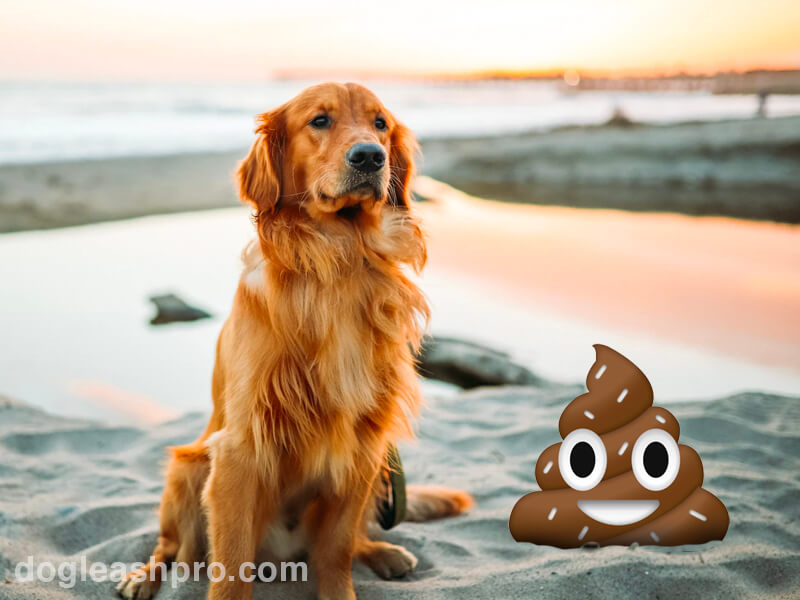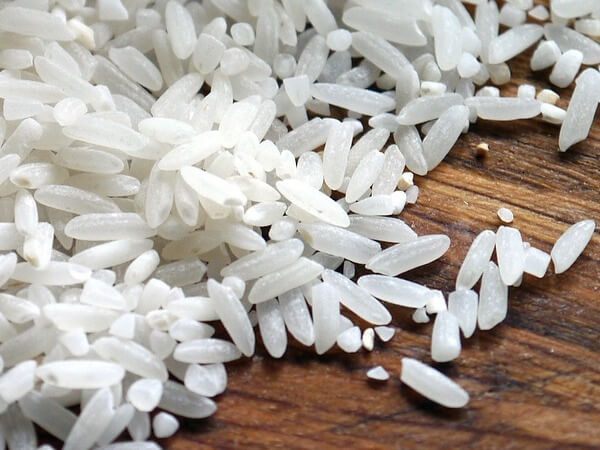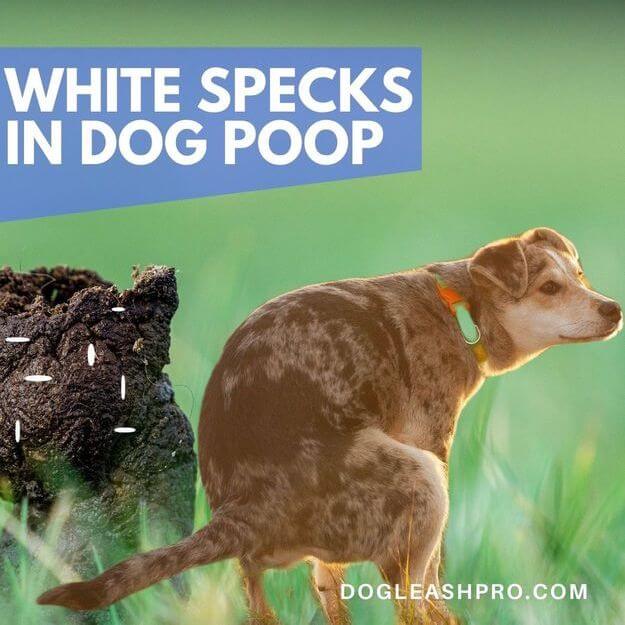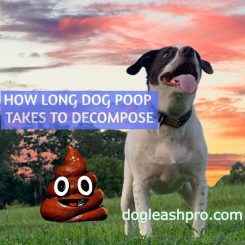
While this is certainly an unpleasant topic, a dog’s poop can give you a lot of insight into their health. Recently, I took my Chihuahua out to go potty and noticed tiny white specks in her poop that were not moving. So I was wondering the following question.
What are the white specks in my dog’s poop? The tiny white specks in dog poop that are not moving and are not worms could be from white rice or traces of bone from food. If the poop has been left exposed for a while, it could be fly larvae on them. The white specks could also be from the medication the dog was taking.
For instance, a dog with kidney failure or disease may have to take medication (usually pills) to improve its kidney functions. Below, we’ll explain what these tiny white specks in the dog poop could be. We’ll discuss what you should be checking for and what you should do about it. Many owners describe them as white seeds or white dots.
Table of Contents
What exactly are these white specks in dog poop?
White specks are tiny white dots in a dog’s poop. If you see or notice them, don’t freak out. It’s actually common and is not always a cause for concern. However, you should not ignore it either.
What should you do if you see tiny white specks in dog poop (not moving and not worms)
When you find white specks in your dog’s poop, the first step is to identify what these white flecks are. Don’t be shocked as the white spots can be harmless.
I know this can be a bit uncomfortable but you will have to bend over and get as close as you can to the dog poop. Take a look for at least 20 to 30 seconds.
Use a long disposable tool to poke at the poop and see if there’s any movement from the white dots or spots. Sometimes, the white specks may appear motionless at first but then suddenly move or twitch so try to be patient.
It’s best to examine multiple poops several times to get a good picture of your dog’s stool and confirm whether the white specks in dog poop are not moving.
If the white dots in your dog’s poop are not moving, then it may not be a cause for concern. There is nothing to worry about since non-moving tiny white specks in puppy diarrhea or dog poop are generally treatable. They usually will not cause your dog any harm.
However, if you see moving white specks in your dog’s poop, speak with your vet as it could be a sign of a serious infection or ailment. It may even be those pesky worms!
What causes white specks in dog poop that are not moving and not worms?
When you take a closer look and notice that the white spots in your dog’s stool are not moving and are not worms, you may wonder what is causing these white dots in the dog poop.
Here are some of the reasons below:
1. Undigested rice in dog stool

White specks in dog poop that are not moving could be caused by the food your dog is eating. If your pup is having a difficult time digesting rice or grains, this could be the white specks you’re seeing.
Since rice or grains are generally intended for human consumption, it may be why your pooch is having trouble digesting them so they pass through his digestive tract as white spots.
It may not surprise many dog owners to learn that their curious four-legged friends love to explore the environment around them by nibbling, eating, or sniffing at things in the backyard or in areas around the house.
If your furry friend is rummaging through your garbage can, they may consume sesame seeds or carrots that you weren’t aware of. This undigested food can show up in your dog’s stool as white chunks or specks if it is not digested properly.
Make sure to keep an eye on your canine friend when he’s outside to ensure he is not eating anything that could potentially show up as white chunks or white spots in dog poop.
You may be interested in: My Dog Has Diarrhea But Is Acting Fine
2. Traces of bone from dog food or treats
Some dog food contains small white traces of bone that are hard to digest even for the toughest of dogs. This may be the reason why you’re seeing non-moving white flecks in your dog’s poop. Take note of the food you’re feeding them.
Unfortunately, even the most expensive dog food can contain small traces of bone. As an owner, you may be terrified to hear this especially when you are trying to buy the best quality food for your four-legged pooch. The good news is that it does not affect your pup’s health.
To expand on this, many dog foods inevitably contain traces of bone or tissues that are causing the white dots in your dog’s poop. Sometimes these bones can irritate your pup’s GI tract and can cause bacterial infections. If you’re not happy with this, we recommend that you select non-meat dog food or have your pooch try vegan-based dog food for a week and see if they like it.
Additionally, many owners like to give their canine rawhide bones or marrow bones for dogs as treats in order to satisfy their furry friend’s innate nature to chew. These treats could be the reasons why there are little white things in dog poop.
3. Undigested medication capsules

Did your pooch take any medication in the form of pills recently? If so, it’s important to keep in mind that the hard casing of the pills could be difficult to break down in their digestive system. Due to this, you may see tiny white spots in the dog poop which can look like white rice.
This usually happens to older or senior dogs when they start taking their medications. Prior to taking the medication, you may not have seen any white spot in their stool. If this is the case, then the white dots in the dog poop are likely due to the medication capsules that haven’t been properly digested.
If you are unsure, consult with your vet and confirm what you’re seeing so that you rule out other dangerous possibilities.
4. Fly larvae in dog poop
The white specks in dog poop could be fly eggs or larvae especially if the poop has been laying around in your backyard for a while. Flies are naturally attracted to moist poop because they like to feed on decaying matter.
When flies land on the poop, they may lay eggs in it. The larvae will then grow by receiving all the nutrients they need from the dog’s poop.
While this means that your pup is healthy and well, we recommend you keep an eye on your backyard. The exponential growth of eggs and larvae could contaminate your backyard and potentially affect your pup.
It’s best to clean up your puppy’s poop right after they’ve done their deed because dog poop does carry infections if it’s laying around for too long. If you leave the feces to decompose on its own, it can damage the grass and plants in your yard and attract maggots.
There may be wild animals running across your backyard that could risk getting infected as well and pick up the disease. When they get infected, it could spread throughout your local wildlife community and other pets in your neighborhood may be affected.
You might also like: How Long Can Dogs Hold Their Poop?
How can I tell if my dog has tapeworms?
Tapeworms are unfortunately the worst possible cause for those little white specks in your dog’s poop. If you suspect your pooch may have them, see your vet immediately so it can be treated as soon as possible.
Tapeworms are dangerous parasites that will attach themselves to the wall of your pup’s small intestines and feed off the food that makes its way through their host’s digestive system. They look like pieces of string or shoelaces and could be as small as 2 inches or as long as 11 inches.
If left untreated, your canine can become ill. This is because the tapeworms will mature into adults and start laying eggs, causing worm infestation inside your dog’s intestines. When your pup poops, the eggs could be found in your dog’s stool. They will look like white seeds or grains of rice in your dog’s poop.
READ ALSO: My Dog Keeps Sitting On His Bum After Grooming: 10 Reasons Why!
Tiny white worms in dog poop
You may notice the eggs moving suddenly after laying still for a while. If you’re unsure whether it’s moving or not, it doesn’t hurt to take a look every other hour to see if the white dots are moving.
If you see white spots around your dog’s anus or suspect signs of tapeworm in your dog’s stool, use a pooper scooper to get fresh samples of the poop and place it inside a ziploc bag. Bring it to your vet for analysis. It’s easy to identify whether it is tapeworms since their eggs are usually bigger than other parasites.
It may take several tests to properly diagnose your dog with tapeworms. Sometimes the eggs continue to stay attached to the adult worm’s body and may take a few days before they detach themselves and end up in your dog’s stool.
Ask your pup’s vet what you should do if your pup has tapeworms. Some suggest deworming treatments but there’s a high chance that this treatment may not completely destroy the worm as it may leave the head of the parasites intact.
It’s possible that the tapeworm head regenerates and leads to tapeworm infection again.
Due to this, your vet will have to see what type of tapeworm your dog has and provide you with the correct deworming treatment to eliminate them as quickly as possible. Timing is crucial because worm infestation could lead to other health issues if it’s not treated early.
If your puppy has a worm infection and they are under 3 months old, many vets recommend that they get a deworming treatment every 2 weeks. If they are between 3 months to 6 months old, deworming treatment should be once a month.
Here is a deworming treatment for dogs that are highly recommended by our vets.
How are tapeworms spread?

When your canine is sniffing around your backyard or eating everything they come across, you may be concerned for their health and safety.
Luckily, when dogs accidentally eat the fertilized tapeworms’ eggs, they should be fine since these parasites must pass through a living host (an adult flea) before they can infect your pups.
For instance, tapeworm eggs found in your dog’s poop get released into the grass or soil. A nearby flea larvae (immature stage of the flea) may ingest the egg. The tapeworm egg inside the larval flea continues to grow as the flea develops into an adult flea.
While out on a walk, your dog may get tapeworm infected fleas on their hair or skin. If your puppy is constantly itching their skin, it could be due to flea bites. Your canine may chew at their skin with their teeth or lick their fur and accidentally swallow the fleas.
Accidental swallowing of fleas can also happen during dog grooming.
If your pup accidentally eats the tapeworm infected fleas, there’s a risk that he may have a tapeworm infection because as the flea is digested in your pup’s intestine, the tapeworm egg is released. After the egg hatches, the worm latches onto your dog’s intestinal lining.
Your furry friend can also become infected by eating other animal hosts such as rats, rodents, rabbits, and birds. Thus, all dogs should be treated for flea prevention as soon as possible.
Identifying worms in dog poop
There are different types of worms that can be found in dog poop. There are tapeworms, roundworms, and hookworms. We will go over each one in detail.
Tapeworm feeds off of your dog’s intestines. The adult tapeworms will lay eggs in the wall of the puppy’s intestine. When dogs accidentally eat fleas, tapeworm is usually the type of worm found in their poop. You may see sesame seed like specks around its anus.
Roundworm looks like white strings in dog poop when your dog accidentally eats spoiled soil or another animal’s feces. If your dog vomits a lot or has irregular bowel movements, it is a sign that your dog could have roundworm.
Hookworm is a dangerous parasite that feeds off your canine’s blood and can enter through their skin. Similar to roundworms, dogs can get hookworms by eating another animal’s feces or spoiled soil so make sure your pup isn’t lying around in another animal’s poop.
Worms you cannot see with your naked eye
There are two dangerous worms that you can’t see with your naked eye and are not found in your dog’s poop. You can find out if your pups have these worms through a blood test.
They are the following:
Whipworms
Whipworm infestation can cause your dog to vomit, pass lots of gas, and experience weight loss.
The scientific term for whipworm infection is Trichuris vulpis. If you haven’t heard, this type of worm is actually very common and it is an intestinal parasite in canines. Whipworm affects the large intestines of dogs, specifically the colon and the cecum.
These one-quarter-inch long worms have thin, long, and posterior ends that look like a whip. They tend to cling onto the mucosal lining of the large intestinal wall and cause discomfort and irritation in dogs.
If you suspect your furry friends have whipworm, seek a veterinary professional right away. If it is not treated immediately, the whipworms can increase. The more whipworms in your dog’s intestine, the greater the irritation will be.
Additionally, large numbers of whipworms can cause diseases and complications not only to your dog but to the wider environment.
For example, when whipworms become an adult, they will lay eggs in your dog’s large intestine. When your dogs do their business, you may find whipworm eggs in their stool.
If the owners forget to pick up the dog poop, the whipworm in the poop can and will infect the soil, other wild animals, and the local wildlife community.
Here are some of the symptoms of whipworms in dogs:
- Bloody stools.
- Anemia.
- Diarrhea.
- Irritation in the large intestines.
- Weight loss.
This is why regular vet visits are important. These visits will allow your vet to perform regular testing to find out if your pooch has internal parasites like whipworms so that this infection can be treated right away.
Whipworm infections that aren’t treated may start to affect your dog’s immune system which will then affect his or her quality of life.
Some dogs won’t show any signs of infection so these vet visits are crucial in order to prevent the infection from getting worse.
Heartworms
Heartworms can affect your dog’s blood vessels, lungs, and heart. They are usually caused by mosquitoes. Coughing constantly could be an early symptom of your dog having heartworm.
Be sure that you bring your pooch to the vet for regular checkups, especially if your dog has recently traveled. If mosquitos are common in your recently traveled location, then it’s best to bring your pups to the vet for a checkup to see if they may have heartworms.
Early prevention is key. Heartworms can usually live inside your pooch for about 5 to 7 years. They look like strands of spaghetti. The female heartworms are longer than the male heartworms at around 10 to 12 inches long. Male heartworms can be as long as 4 to 6 inches long.
There can be as little as one heartworm or as many as 250 heartworms. The average number of heartworms in dogs is 15.
There are four stages of heartworm disease in dogs:
Stage 1
Usually an occasional cough and mostly showing no signs or symptoms.
Stage 2
The symptoms become more mild. Your pooch may cough occasionally and become tired after walking, running, or jogging. If you notice this, take him to the vet immediately so that your vet can perform a chest x-ray. The lungs and heart may change during this stage.
Stage 3
During this stage, the symptoms become more severe. The occasional cough is now more frequent and persistent. Your pooch may look tired after running and walking. You’ll notice that his breathing is more laborious such that he is breathing harder and requires more energy to simply breathe.
He may also show signs of heart trouble. Similar to stage 2, we highly recommend that you take your pooch to see the vet. A chest x-ray is necessary to see if there are changes to the heart and lungs.
Stage 4
Be sure to catch this disease early. As time passes, there may be more worms growing inside your dog’s body. Keep in mind that female heartworms can lay eggs. When there are so many worms, it can block the blood from flowing back into your dog’s heart. This is called caval syndrome. When this happens, it becomes life-threatening.
Time is of the essence here to remove the heartworms. The best treatment option is to remove the heartworms surgically. Unfortunately, the surgery is very risky. Many dogs do die from caval syndrome even after surgery.
FAQS
There are a few reasons why you’re seeing white specks in dog poop. It could be from traces of bone or undigested food like rice in their stool. If the white spots are moving, it could be from fly larvae especially if the poop has been laying in the yard for a while. One of the common causes of white specks in dog poop is worms. Be sure to check their poop as it can tell you a lot about your dog’s health.
If you notice moving white specks in dog stool, it could be a sign of a worm infection. Some common types of tiny white worms found in dog poop are tapeworm, hookworm, or roundworm. Ask your vet for the best deworming treatment for your pup.
The first sign is if you see moving white specks in dog stool. The second is if your pup is frequently dragging or scooting their rear end against the floor. Lastly, certain types of worms can cause symptoms such as irregular bowel movements or vomiting.
Tapeworms look like tiny white dots or spots in dog poop. If you stare at the poop closely for at least 30 seconds, you may notice the white dots moving. If your pup has tapeworm, you may see little sesame seed-like specks around your dog’s anus.
One of the treatment options is to start an ongoing heartworm prevention medication and wait for the heartworms to die out. This treatment helps to stop the larvae from growing. Adult worms have a 3 year lifespan. Be sure to speak with your vet if there are other treatments available.
If the dog’s poop looks like it has seeds in it, it could be one of the following: traces of bone, undigested food like rice, fly larvae, or worms. Take a closer look to see if the white specks are moving or not.
Tapeworm eggs look like grains of white rice or white seeds in dog poop.
Unfortunately, dogs cannot get rid of worms on their own. If you suspect your pooch has a worm infection, visit your vet immediately. The vet will properly diagnose the condition, identify the type of worm, and prescribe the appropriate deworming treatment. These treatments can be administered at home, either orally or through an injection.
DISCLAIMER: THIS WEBSITE DOES NOT PROVIDE MEDICAL ADVICE
The information, including but not limited to, text, graphics, images and other material contained on this website are for informational purposes only. No material on this site is intended to be a substitute for professional veterinary advice, diagnosis, or treatment. Always seek the advice of your veterinarian or other qualified health care provider with any questions you may have regarding a medical condition.

With over five years of specialized experience as an animal writer, my expertise lies in dog nutrition, health, behavior, grooming, and training. I am dedicated to delivering helpful and informative content that caters to the well-being of our furry friends. My primary goal is to empower pet owners with knowledge and ensure our canine companions thrive in health and happiness. In my free time, I love volunteering at local dog rescue centers.









